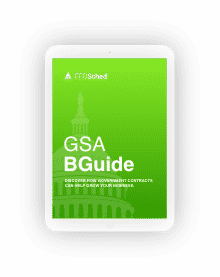Tips for Marketing Your GSA Schedule Contract
A GSA Schedule Contract is a valuable tool for building your government business, but a strong foundation is needed for any successful build. A well-planned marketing strategy serves as the foundation for both commercial and government business. However, the government sector is unique and requires a specialized marketing approach.
Here are five mistakes to avoid while marketing to the federal government.
1) Don’t Use Commercial Collateral & Messaging
While it is tempting to use the same marketing material and messaging intended for commercial targets, it does not tend be an effective practice. Collateral centered around commercial needs and commercially focused language (company/profits vs agency/efficiency) is not going to capture the attention of potential government customers. Take the time to create and rework key collateral, so it speaks to your target audience.
2) Don’t Attempt to Target the Entire Federal Government
No matter how useful your product or service, it is unlikely that it will be a perfect fit for the entire federal government. The federal government as a whole is simply too large and diverse to clump together into a single plan of action. Attempting to do so wastes time and resources.
Research is essential in determining the best agencies to target with your government marketing plan. Determining which agencies to target can seem daunting but there are resources to aid in the process. USASpending.gov is a user-friendly site where you can search for contract awards by State, NAICS Code, Product/Service Code, Agency, and Socio-Economic Status.
3) Don’t Departmentalize Your Government Marketing Strategy
Don’t create your marketing strategy in a silo. An effective government marketing strategy is dependent on a number of factors and information shared across company departments. Lack of communication with other departments or failure to consider metrics will limit your impact.
4) Don’t Take a “Set-It-And-Forget-It” Approach
What works today may not be a successful strategy 24, 12, or even 6 months from now. Your government marketing plan should be dynamic. Test, measure, and reevaluate on a regular basis to capture changes to the market and adjust your strategy accordingly. Metrics are essential to a successful marketing plan. Metrics will help you determine what marketing tactics are working and what tactics need revisiting. The metrics you track will depend upon your goals, but some examples include:
– Page Views/Conversions on GSA Schedule Contract Landing Page
– Email Campaign Open and Click-Through Rates
– Shares and Follows on Social Media
5) Don’t Ignore the Power of Digital & Social Media
While face-to-face relationship building is still very important in the government space, ignoring digital marketing channels such as your website and social media is a huge missed opportunity. Maintaining an up to date website is the starting point. A blog can be beneficial, but it’s important to post on a regular basis. Social media, including LinkedIn and Twitter, serves as an additional platform to maintain communication with both existing and potential customers.
Use social media pages to share industry news, promote company accomplishments, and expand your network. While your branding and tone should be consistent across all platforms, avoid sales pitches in social media presence.
Keep in mind, social media is not only a platform to reach potential customers, but a research tool for learning more about your customers and finding potential opportunities.
Just like your government marketing strategy, your GSA Schedule Contract is not a set-it-and-forget-it item. Don’t forget to make changes to your contract as needed, whether that be a change to your pricing and offering or your point of contact information.
Be proactive in pursuing opportunities through the GSA Schedule Contract. Register on eBuy and monitor it regularly for relevant RFPs. eBuy is one of the exclusive benefits for GSA Schedule Contract holders. Don’t let this fall by the wayside.
